Easy Immersion Blender Hollandaise Sauce
Hollandaise sauce is a classic French sauce known for its rich, creamy texture and tangy flavor. Traditionally made by whisking egg yolks, lemon juice, and melted butter over gentle heat, hollandaise can be a daunting sauce to master. But, with the help of an immersion blender, you can make a velvety-smooth hollandaise sauce with little effort in under ten minutes.
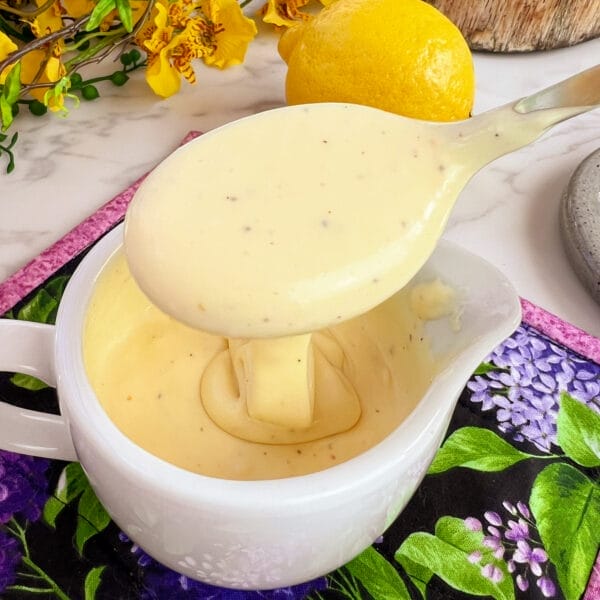
Also Read: How to Season Vegetables, 15 Ways to Jazz Up Condiments, Steamed Asparagus
Favorite Recipes Using Hollandaise Sauce
- Eggs Benedict
- Grilled or poached fish
- Steamed vegetables
- Steamed asparagus
- Chicken or steak
- Breakfast hash or potatoes
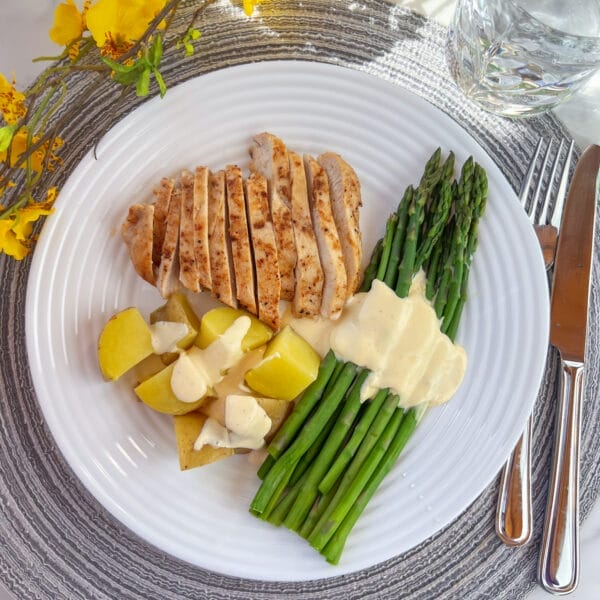
Frequently Asked Questions About Making Hollandaise Sauce
How to Store Sauce
Hollandaise sauce is best enjoyed fresh, it’s best to make in small batches. It can’t be frozen and it’s tricky to reheat. This is one time when I encourage you not to make extra!
If you do have leftovers, store in an airtight container in the refrigerator for up to 2 days.
How to Reheat Hollandaise Sauce
Carefully – low and slow is the name of the game when reheating hollandaise sauce. It will turn lumpy and loose it’s beautiful smooth texture if it gets too hot – even a little bit. Reheat hollandaise sauce gently over low heat, stirring constantly to ensure it heats evenly and doesn’t curdle.
To best control the heat, reheat the entire dish in a pot of hot water, stirring slowly. Or use a microwave at 50% power at 20 second intervals, stirring in between each time.
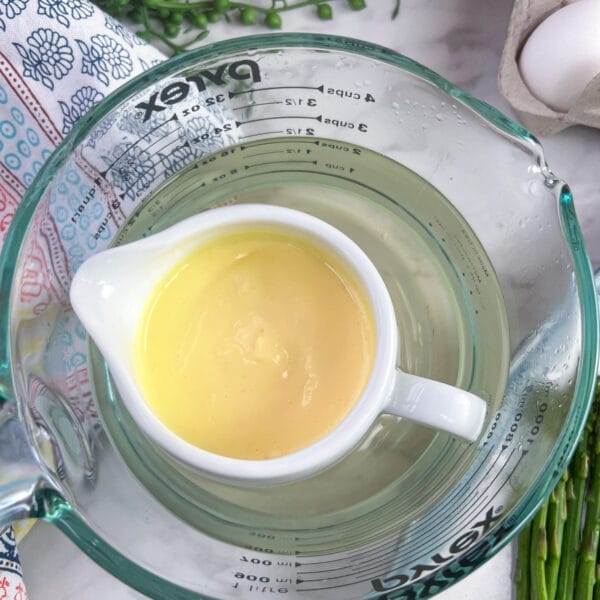
Can You Fix Broken Hollandaise Sauce?
Yes, if it’s not too far gone, you can bring back hollandaise sauce. I was able to bring back the broken emulsion shown above by gently reheating it, adding a splash of water and mixing it with the blender again. If that doesn’t do it, start with a fresh batch of egg yolks and slowly incorporate the broken sauce into the new yolks.

Do I Need Clarified Butter?
While clarified butter is traditionally used for hollandaise sauce and will give you the ultimate in smoothness – it’s not necessary. I have never used clarified butter and I am still very happy with the smooth texture of my sauce. All of the photos you see on this page were made with non-clarified butter – just regular butter heated.
To clarify butter, melt it in a pan over low heat, allow the butter to separate into three layers: the clear, golden liquid in the middle & top, the milk solids settled at the bottom, and the foamy layer on the surface. Skim off the foam and strain out any milk solids at the bottom, leaving behind the clear, clarified butter. Or use ghee which is essentially clarified butter with a slightly different flavour based on extended heating of the butter.
By the way I also use black pepper and cayenne pepper – which you can see in the sauce. If you want to have extra fancy pure sauce – use white pepper only.

How is Hollandaise Sauce Made?
If you’re like me and marvel at how emulsions like this hollandaise sauce work, you’ll want to read this to understand how all the pieces and processes work together:
- Emulsification: The emulsification process is crucial to hollandaise sauce. Egg yolks contain lecithin, a natural emulsifier that helps bind water and fat together. When you blend the egg yolks with the melted butter, the lecithin in the yolks helps stabilize the mixture, preventing the fat (butter) from separating from the water-based components.
- Temperature Control: Temperature control is essential for the success of hollandaise sauce. The egg yolks need to be cold because they emulsify better when cold, and they’re less likely to curdle when heated slowly. Cold yolks also help control the rate at which the sauce thickens, preventing it from becoming too thick too quickly.On the other hand, the butter needs to be hot but not browned. Heating the butter serves two purposes:
- It helps melt the butter completely, ensuring a smooth texture in the finished sauce.
- The heat of the butter aids in cooking the egg yolks gently as they blend, which helps stabilize the emulsion.
- Blending: Blending the egg yolks and butter together is what creates the creamy, thick consistency of hollandaise sauce. Using an immersion blender allows for thorough mixing and incorporation of the butter into the yolks, resulting in a smooth texture.
- Thickening: As the egg yolks and butter blend together, the proteins in the yolks denature and coagulate, thickening the sauce. The emulsification process traps air bubbles within the mixture, further contributing to its creamy texture.
- Seasoning: The addition of lemon juice, salt, and pepper not only adds flavor to the hollandaise sauce but also helps balance the richness of the butter and egg yolks. The acidity from the lemon juice also plays a role in stabilizing the emulsion.
All that in under 10 minutes! How cool is that!
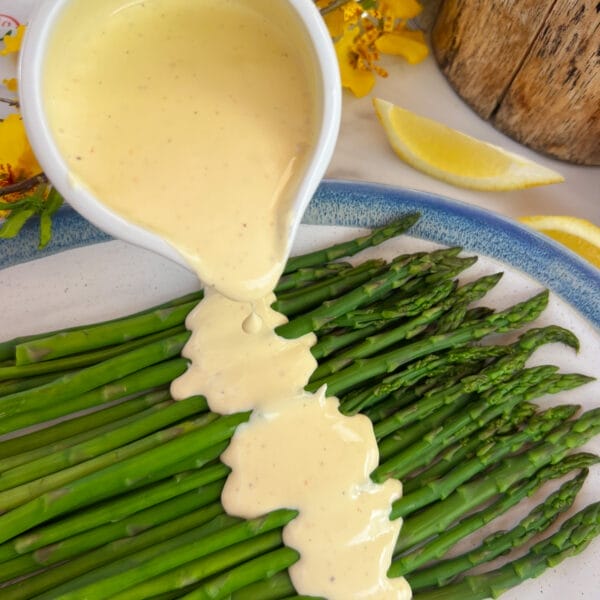
Recipe for Immersion Blender Hollandaise Sauce
Easy Immersion Blender Hollandaise Sauce
Ingredients
- 2 egg yolks
- 2 tsp water
- 1 Tbsp lemon juice
- 1/4 tsp salt
- 1/8 tsp white pepper or black
- pinch cayenne pepper optional
Instructions
- Place egg yolks in high, narrowcontainer that fits immersion blender. Blitz to break the egg yolks.
- Add water, lemon juice, salt, and peppers. Blitz until smooth.
- Melt butter in small saucepan and transfer to container with spout for easy pouring.
- Start immersion blender in egg mix and keep it running while slowly pouring in a small stream of hot butter. You can stop pouring and move the stick blender around to ensure all the hot butter is incorporated. Continue until all the hot butter is incorporated.
- Taste and adjust seasoning or thickness as desired. If sauce is too thick, add a teaspoon more water or lemon juice at a time.
- Use immediately or keep warm by wrapping in tea towel or placing container in a bowl of hot water. The sauce will thicken considerably when cooled.
Notes
Nutrition Facts (per serving)
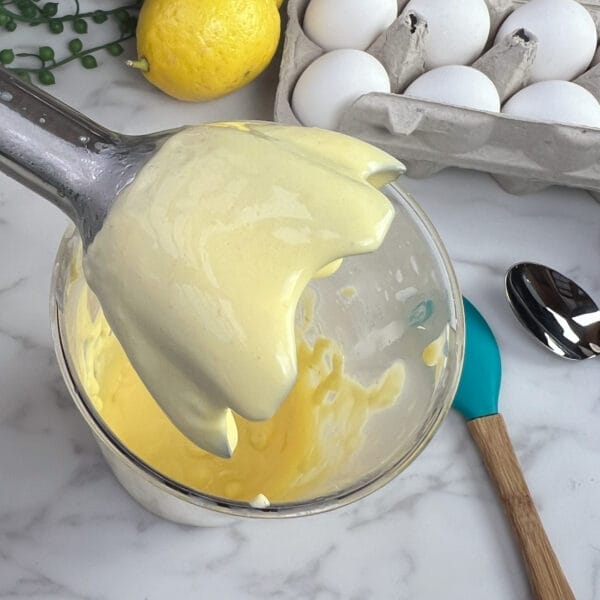
Will you try making your own hollandaise sauce? I’d love to know what you think. Leave a comment and tag me on Instagram @getgettys when you give it a try.
Select, store and serve seasonal food for everyday cooking with Getty. Getty is a food educator and Professional Home Economist, who loves sharing tips and recipes following the seasons from her Canadian kitchen. Sign up to get seasonal tips and recipes delivered to your inbox. Learn more about Getty or check out her books and pdf guides.


